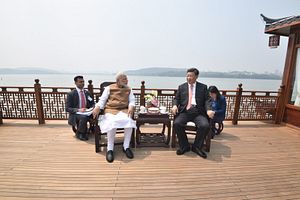The informal summit between Indian Prime Minister Narendra Modi and Chinese President Xi Jinping may not be “a milestone in bilateral relations” as sections of the Chinese media have suggested, but it certainly has the potential of changing the trajectory of Sino-Indian relations in a positive direction. The fact that it allowed the two leaders to exchange views in a relaxed environment without any scripted agenda is in itself an achievement given the negativity of the last two years. Given the stakes that China and India have in each other’s stability and success, it is imperative that the top leadership of the two nations to be in regular touch with each other and not allow military commanders or a belligerent media to shape bilateral discourse.
On the longstanding border issues, Modi and Xi have decided to issue strategic guidance to their respective militaries to strengthen communication in order to build trust and mutual understanding with the overall aim of “maintaining peace and tranquility in the border region.” The two leaders also underlined the common threat posed by terrorism and committed to cooperate further on counterterrorism. In an important move and one likely to raise hackles in Pakistan, they agreed to undertake a joint economic projects in Afghanistan. If operationalized, this can be a game changer for Afghanistan and regional peace. After the summit, Beijing also made it clear that while there were no fundamental differences with India on the issue of “inter-connectivity,” China won’t be “too hard” with New Delhi on the issue of the Belt and Road Initiative (BRI).
At a time when the protectionist tendencies in the West are growing by the day, the need for India and China to work together in global governance was also highlighted during the summit. The Chinese President argued: “As the two largest developing countries and emerging-market economies with a population level of more than one billion, China and India are the backbone of the world’s multipolarization and economic globalization.” He underscored the importance of building an open and pluralist global economic order in which all countries can freely participate to pursue their development, while also contributing to the elimination of poverty and inequality in all regions of the world.
It is clear from the summit that key bilateral differences continue to plague the Sino-Indian relationship. Structural factors that have determined the trajectory of this relationship for the past two decades continue to be influential and are not going to disappear overnight. What is equally clear is that top leaderships in both countries are cognizant of the challenges that bedevil their relationship and would like to stabilize their relations.
Just before the summit, India reiterated its opposition to the BRI as well Pakistan sponsored terrorism even as the growing trade imbalance with China has been highlighted repeatedly. Contrary to what many seem to be suggesting, India did not go into this summit from a position of weakness. After standing up to the Chinese border adventurism on Doklam last year and by taking a principled but consistent position on China Pakistan Economic Corridor (CPEC), India made it clear to China that it will not succumb to brute Chinese power.
It is because of this reason that, finally, the Chinese president accorded the Indian prime minister the honor of an informal summit, which is rare and usually reserved for American presidents. It is China that is facing negative headwinds today with the Trump administration’s clamp down on tariffs and voices growing around the world against the predatory practices of the BRI. At a time when China is yet to complete its restructuring of the domestic economy, it is important for Beijing to work together with New Delhi given the shared global economic climate.
The idea that India and China share convergent interests on the global stage and so need to work together is not new. Throughout the early 1990s, it was this idea on which the broader Sino-Indian partnership was predicated upon. In fact, the Russia-India-China trilateral arrangement and the BRICS platform evolved out of this synergy. India and China spoke in one voice against Western interventionist policies in the 1990s and stood up against the West in global trade and climate change negotiations. It is recently that this engagement has been weakening partly because Beijing seemed more keen on reaching bilateral understanding with major western powers without taking New Delhi into account.
If today China is once again taking about working together with India on global economic issues, there seems to be a realization in Beijing that Western opinion is turning against it rather rapidly. China would need partners which can help it alleviate some of these challenges. Its traditional partner of choice, Russia, won’t be of much help as it not only is not fully integrated into the global economic order, but has also burned its bridges with the West. India, meanwhile, remains an emerging economic power both with the heft and credibility to shape the global economic architecture in partnership with the West.
This is certainly a moment for New Delhi to tap into and use this opportunity to its fullest. Modi’s visit to China is a welcome first step. But New Delhi will need to be aware that unless there is a real change on the ground in China’s policies towards India, this summitry, like past several ones, will soon be forgotten.

































